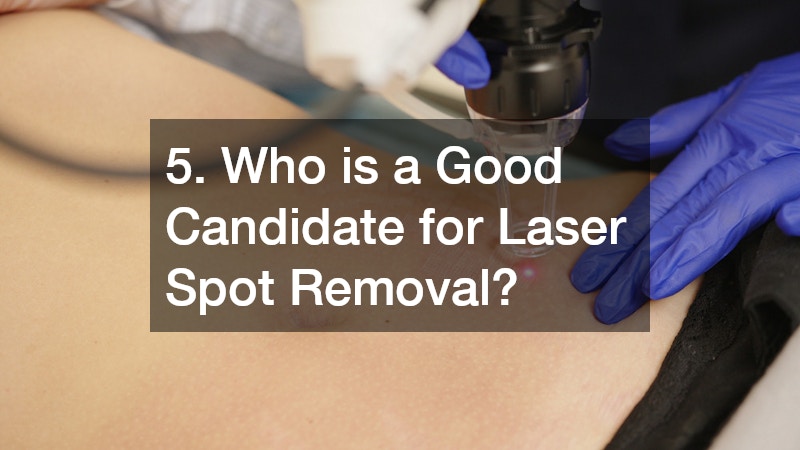The popularity of laser spot removals has been on the rise, driven by both technological advances and increased public awareness. As more people seek effective solutions for skin imperfections, laser treatments are becoming a preferred choice.
1. What are Laser Spot Removals?
1.1 Understanding the Procedure
Laser spot removal works by targeting the pigment in skin spots with focused light energy, breaking down the pigment particles for the body to naturally eliminate. This scientifically-backed procedure offers precision and efficacy, making it a sought-after option for many seeking clearer skin.
The technology involves using specific wavelengths of light energy that penetrate the skin and target blemishes without affecting surrounding tissues. By leveraging the skin’s natural healing processes, laser treatments promote more even skin tone and texture.
As the laser energy is absorbed by the pigment, it causes the unwanted spots to fragment, facilitating their gradual disappearance. This minimally invasive procedure offers a reliable alternative to traditional spot removal methods.
1.2 Types of Spots Treated
Laser treatments can effectively address a range of skin spots, including sunspots, age spots, and freckles. This versatility makes laser spot removal an appealing choice for individuals with various skin concerns.
Additionally, lasers are used to treat post-inflammatory hyperpigmentation and other pigment-related conditions, further expanding their utility. Whether spots are due to sun exposure or aging, laser technology can provide a solution.
Not limited to facial treatment, laser spot removals can be applied to other areas of the body, enhancing their appeal. The broad application range of laser therapy underscores its effectiveness in cosmetic dermatology.
2. Why are Laser Spot Removals Gaining Popularity?
2.1 Increasing Awareness and Accessibility
Greater public knowledge about the benefits and safety of laser treatments has contributed to their growing popularity. As awareness increases, more people are considering laser procedures as viable options for spot removal.
The expanding network of clinics offering laser treatments has also made these procedures more accessible to a larger audience. Competitive pricing and flexible payment plans further encourage adoption among individuals seeking aesthetic improvements.
Furthermore, social media platforms play a crucial role in educating potential clients about laser spot removal. Testimonials and before-and-after images shared online amplify awareness and interest in these effective treatments.
2.2 Enhanced Technology
Recent advancements in laser technology have resulted in safer, more effective procedures, increasing patient confidence. Innovations such as improved laser precision and cooling mechanisms minimize discomfort and enhance outcomes.
Developments in laser machinery have led to devices capable of targeting a wider range of pigmented lesions, expanding their efficacy. As technology continues to progress, laser treatments become increasingly efficient and appealing.
Incorporating modern technology into laser spot removal procedures ensures consistent results and reduced risk of complications. Such enhancements have positioned laser treatments at the forefront of modern cosmetic solutions.
3. What are the Benefits of Laser Spot Removal?
3.1 Effectiveness and Results
Laser spot removal provides noticeable improvements in skin clarity and appearance, producing satisfying results for many patients. The ability of lasers to precisely target pigmentation results in the effective removal of unwanted spots.
With a high success rate, laser treatments are often preferred over topical creams and home remedies. Patients frequently report increased confidence and satisfaction with the outcomes of their laser procedures.
The longevity of results is another advantage of laser spot removal, as many patients enjoy long-lasting improvements. This effectiveness makes laser procedures a worthwhile investment for those seeking permanent solutions.
3.2 Minimal Downtime
Compared to other cosmetic treatments, laser spot removal offers minimal recovery time, allowing patients to return to their regular activities quickly. This convenience is especially appealing to individuals with busy lifestyles.
The non-invasive nature of laser treatments means less discomfort and fewer side effects post-procedure. Patients appreciate the ease of undergoing treatment without significant disruptions to their daily routines.
With only mild redness or swelling, typically subsiding within a few days, laser spot removal is known for its low-impact recovery. The minimal downtime enhances the attractiveness of laser procedures for spot removal.
4. Are There Risks Involved with Laser Spot Removals?
4.1 Potential Side Effects
Despite the benefits, it is important to consider potential side effects such as temporary redness, swelling, or pigmentation changes. These effects are usually mild and resolve without intervention.
However, more severe complications, though rare, can include blistering and scarring if not performed correctly. Choosing an experienced practitioner significantly reduces the likelihood of adverse outcomes.
Understanding these risks underscores the importance of informed consent and selecting qualified professionals for laser treatments. Proper care and consultation mitigate risks and enhance patient safety.
4.2 Safety Measures
Maintaining high safety standards is crucial in laser spot removal for protecting clients and achieving optimal results. Reputable clinics adhere to stringent protocols to ensure laser procedures are performed safely.
Pre-treatment assessments help identify suitable candidates and tailor procedures to individual needs. Comprehensive consultations ensure both client and provider are aligned on expectations and risks.
Additionally, post-procedure care instructions are vital in promoting healing and preventing complications. Following these guidelines is essential for achieving desired results safely and effectively.
5. Who is a Good Candidate for Laser Spot Removal?
5.1 Skin Types and Conditions
Candidates for laser spot removal typically have lighter skin tones, as lighter skin responds more favorably to laser treatments. Darker skin types may require specialized lasers to avoid undesirable side effects.
Conditions such as sunspots and hyperpigmentation respond well to laser treatments, making them ideal candidates. However, certain conditions or medications may contraindicate laser usage.
5.2 Age and Lifestyle Considerations
Age is another factor that affects candidacy, as younger skin tends to heal faster and respond better to treatment. Lifestyle habits, including sun exposure and skincare routines, also play a role in determining eligibility.
Professionals assess various lifestyle factors to tailor treatments effectively, maximizing outcomes for each patient. Adopting protective measures, such as regular sunscreen use, enhances laser treatment results.






